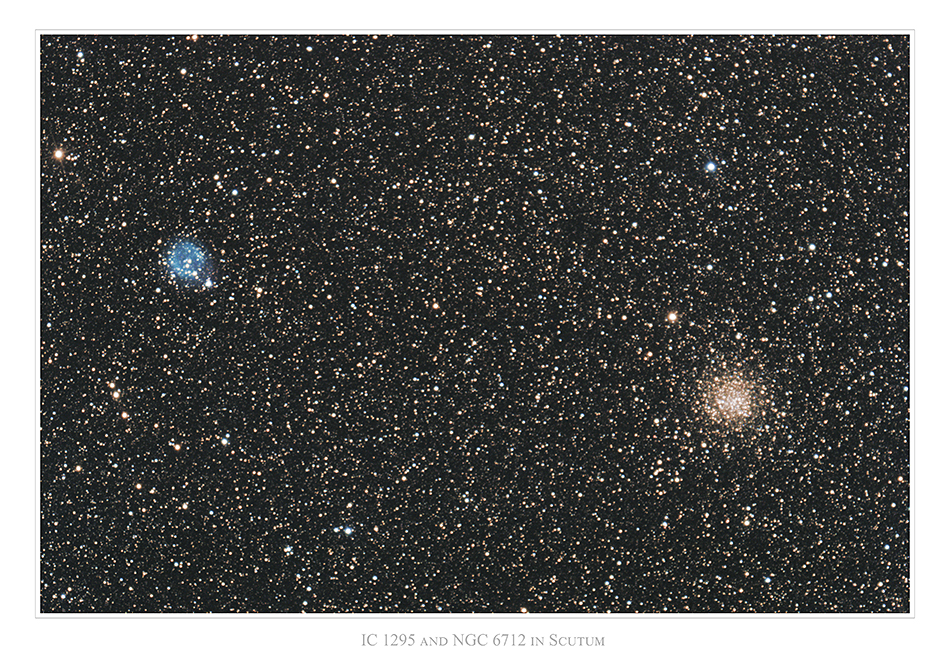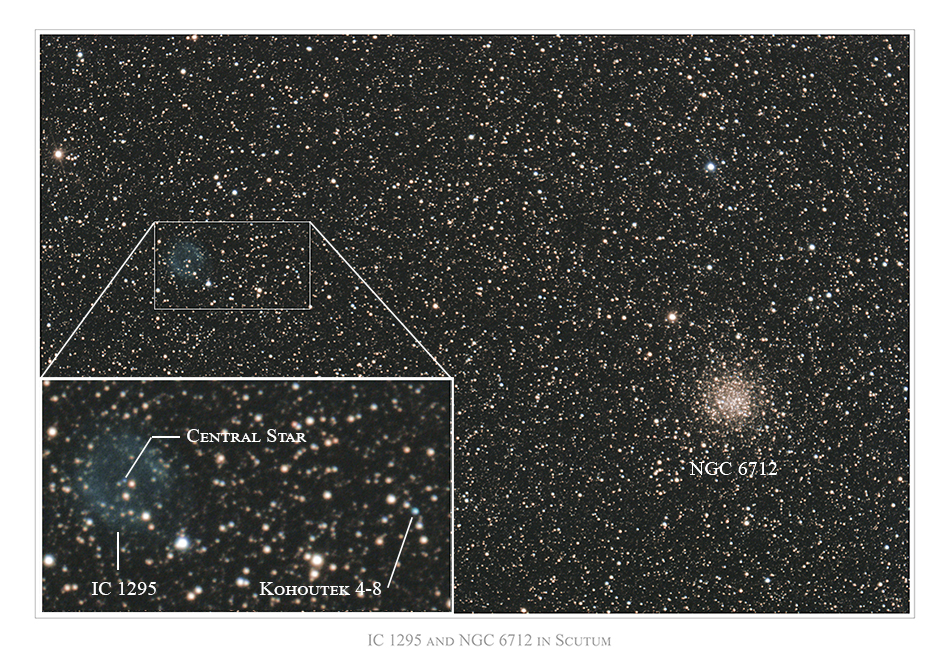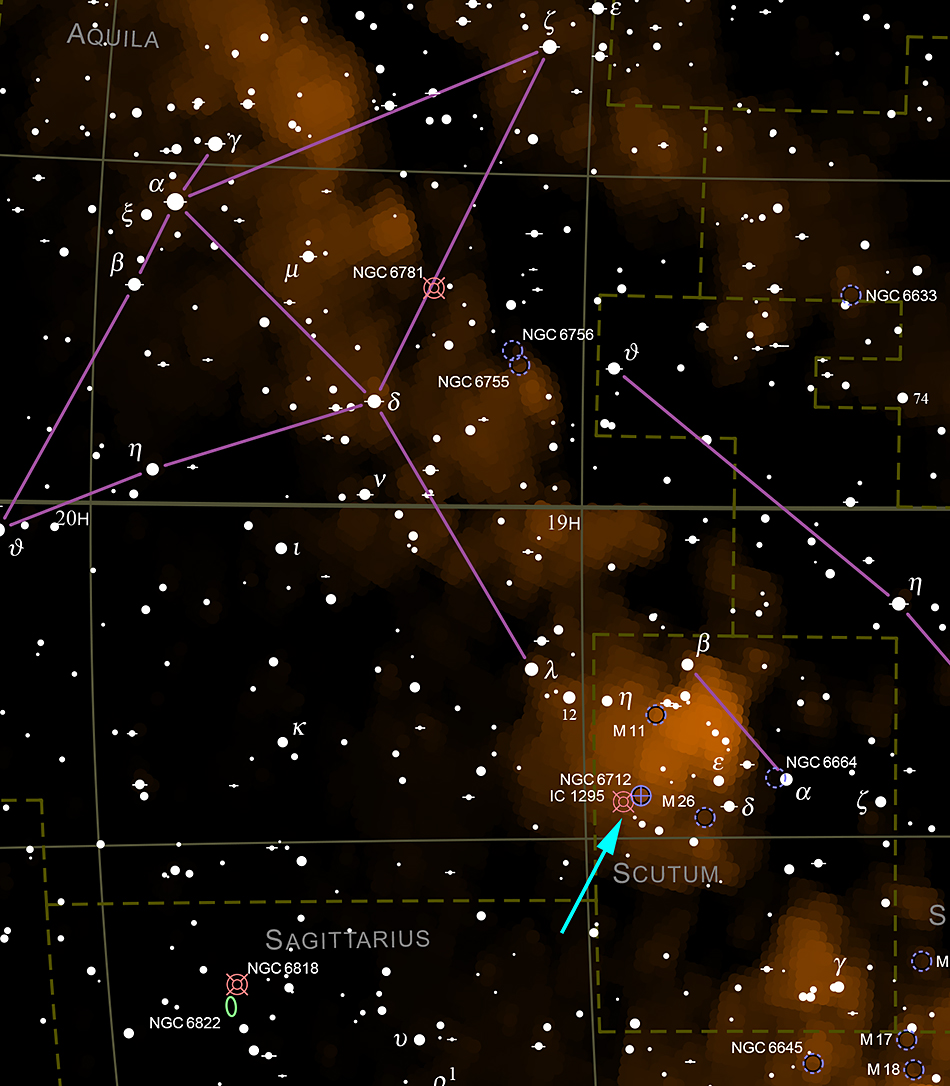


|

|

|
| Object: | Constellation: | Coordinates: | Size: | Brightness: |
| NGC 6712 | Sct | 18h53m / -08°42' | 7.2' | 8.7mag |
| IC 1295 (PK 25-4.2) |
Sct | 18h55m / -08°50' | 1.7' x 1.4' | 12.7mag |
| Kohoutek 4-8 (PK 25-4.1) |
Sct | 18h54m / -08°48' | Stellar (0.7" x 0.5") | 14.0mag |
| The globular cluster NGC 6712 and the planetary nebulae IC 1295 (PK 25-4.2) and Kohoutek 4-8 (PK 25-4.1) in the
constellation Scutum, photographed on August 3 / 4, 2018. The globular cluster NGC 6712 is 21'000-26'000 light-years from Earth (the main source of the distance uncertainty is the strong reddening due to dust) and was discovered by French astronomer Le Gentil in 1749. The cluster is 12 billion years old and its orbit around the Milky Way galaxy brings it fairly close to the galactic center: The excentric orbit takes NGC 6712 to within 1000 light-years of the galactic center (it is currently 11'400 light-years from the center). Astronomers believe that the tidal forces of the Milky Way stripped the low-mass stars away and are driving the remaining star cluster toward dissolution. The planetary nebula IC 1295 is approximately 3600 light-years from Earth and was discovered by the American astronomer Truman Henry in 1867. It has the unusual feature of being surrounded by multiple shells that make it resemble a micro-organism seen under a microscope, with many layers corresponding to the membranes of a cell. The central star is 15.0 mag bright. The planetary nebula Kohoutek 4-8 is probably very young. The barrel-shaped nebula spanning roughly 0.7" x 0.5" is perhaps a couple of tenths of a light-year across. Sources: -Wikipedia. -Paltrinieri, B.; Ferraro, F.; Paresce F.; June 2001, The Astronomical Journal, 121: 3114-3126. -French, S.; October 2015, Australian Sky and Telescope, 88: 51-53. -Dauphole, B., Geffert, M., Colin, J., Astronomy and Astrophysics, 313, 119-128. Twenty-three exposures of 3 minutes at ISO 800 were stacked with no dark frame subtraction with Deep Sky Stacker (resulting in a 1 h 9 min exposure) and further processed in Photoshop. For the image, an Artesky 550 mm flat field generator was used to reduce vignetting caused by the camera and the telescope. |
Equipment: Canon EOS 450D Baader modified camera, TeleVue Paracorr Type II coma corrector, 16" f/4.5 "Ninja" dobsonian telescope riding on a dual-axis Tom Osypowski equatorial platform, Lacerta MGEN autoguider, Lacerta off axis system (field of view comparison: image of the moon with the same equipment). |

|
| A stack of just eight 3-minute frames of the three objects mentioned above. In the zoomed view, IC 1295 and the bluish star-like Kohoutek 4-8 are labelled. |

|
|
Search chart for NGC 6712 and IC 1295. Map © 2018 "The Mag-7 Star
Atlas Project", www.siaris.net. Map is modified. The Mag-7 Star Atlas Project map can be downloaded
here . You can improve your deep-sky object search skills here . |

|

|